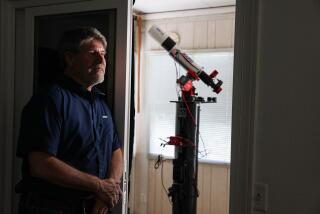Star of the Keck: Atop the Cosmos in Hawaii
- Share via
MAUNA KEA — In the thin air of Mauna Kea’s summit, 300 tons of glass and steel pirouette as silently as a ballerina. A mile below, marshmallow clouds turn sunset pink. The red glow of still-active volcanoes on the far side of Hawaii’s Big Island gleams through the overcast.
With a horrible crunch, the world’s largest optical telescope drops its two jaw-like hatches one at a time, opening its twin throats to drink in starlight.
The Keck telescope is ready to receive the universe.
Waiting in the control room to catch the faint stellar messages written in light from the far reaches of the cosmos is the astronomer whom the telescope operator calls “the star of the Keck.” She’s not what you think.
Looking too youthful to be a tenured professor, she wears a “lucky sweater” in bright primary colors and munches Oreos and Chips Ahoy--the standard fuel for astronomers facing long, cold nights.
At 33, UCLA’s Andrea Ghez has already changed the way astronomers think about star birth. Now, she has put 25 years of speculation to an end by providing the best evidence yet that a massive black hole sits at the center of the Milky Way. She presented her results at a talk last week at Rutgers University in New Jersey.
Ghez first shook up the astronomical community with her discovery that most newborn stars appear to be twins. Astronomers have known since the 1970s that roughly half the stars in the universe come in pairs. What was unclear was whether they were born double, or teamed up two by two later in their evolution, like animals on Noah’s ark.
While still a graduate student, Ghez found that the youngest infants in the stellar family are more likely than older stars to be twins. That means, she says, that stars are probably born double.
The discovery has posed a major problem for astronomy because it contradicts the prevalent theories of how stars form. The theories describe a single star condensing out of a glob of interstellar gas. As the gas collapses under the force of gravity, a star is born. Those theories do not provide any good mechanism to explain the formation of double stars.
“The [current theory] very nicely produces our sun and planets,” she says. “But it only produces single stars. Nature produces doubles. Single stars might be harder to find than we thought.”
Her discovery also raises the question of what happens to all the missing partners of the solitary stars like our sun? “That we don’t understand,” Ghez says.
A Premier Observing Site
It is to figure out puzzles of this sort that astronomers come to Keck. Until larger scopes are built, Keck remains the pinnacle, the place where the best and brightest go to view the farthest and dimmest. Of every four astronomers who submit proposals to peer through one of its giant eyes, only one is chosen.
The rarefied air is one of the attributes that makes Mauna Kea a premier observing site. For one thing, there’s not as much atmosphere at 13,800 feet to soak up precious starlight. For another, the ocean of water surrounding the island keeps the air at a stable temperature, minimizing distortions that, in more turbulent skies, can make stars seem to wiggle around like pennies at the bottom of a pool. During the day, the lava-encrusted mountain exhales clouds from a layer of permafrost, 40 feet below the surface; at night, the clouds sink below the peaks, clearing the view for stargazers.
On the summit, there is only lava and sky. The only life forms are the astronomers who colonized this unearthly landscape, covering the mountain with silver and white pods that appear as if aliens had indeed landed.
Standing on tiptoe to reach the stars, astronomers can see with better resolution than from any other telescope except (and occasionally including) the space-based Hubble.
The multi-mirrored Keck is a wonder of engineering. Each 33-foot-diameter mirror is fashioned from 36 segments working together to make the world’s largest “light buckets,” as astronomers like to call them. Each eight-story scope floats on oil bearings. When the brakes are off, you can push them with one hand. Eventually, the two scopes will work together, producing images equivalent to a telescope with a single mirror more than 93 feet in diameter.
But this sky-high lookout comes with a downside. At 13,800 feet, there’s only half the normal supply of oxygen, and human brains don’t function at full speed.
Jon Krakauer’s “Into Thin Air” is popular reading on the mountain; it’s the story of climbers who perished atop Everest due to high altitude judgment errors.
“I don’t think as well up here,” says Ghez. “If I’m working on the instrument, conversations in the background annoy me. I can’t do two things at once.”
Adding to the problem, the astronomers don’t get much sleep. At dawn, they’ll drive downhill to their mid-mountain base, turning in for a “night’s” rest just after breakfast. They wake around 2 p.m., analyze data and get ready for the next night’s work. Dinner at 4. Then back to the summit.
Six or more astronomers may spend the night in the Keck control room, communicating with the telescope through computers. Inside, the atmosphere can switch from playful to testy in an instant.
“You put together a diverse group of people,” says Ghez. “And if someone [makes you angry], you can’t go outside to cool off.” Not when the temperature on the summit is well below freezing on the balmiest nights.
Time is so precious on Keck that one cloudy night can wreck a research project.
“Sometimes you feel like a project is cursed,” she says. “If you have only one night, and that night is lost. . . . There’s too much to do in too little time.”
As the Earth whirls beneath the sky, different stars come into view. So Ghez comes ready with a laundry list of things to look at.
This night, the astronomers can hardly contain their excitement. One of Keck’s two giant eyes focuses on a young star called HR 4796 with a disk around it that appears to be warped like a phonograph record left out in the sun.
Astronomers have learned over the past decade that many stars are girdled by disks of gas. They theorize that the disks are leftovers from the process of star formation during which the newly igniting star’s gravity gobbled up most of the matter in its vicinity. The matter left over in the disks, astronomers think, is the stuff that eventually condenses into planets.
But can planets readily form around double stars? If they cannot, and if lonely stars like our sun are rarities, then how many other solar systems are there?
“If you want to ask: ‘What’s the potential for life out there?,’ she says, “first you have to ask: ‘What’s the potential for planets?’ ”
Ghez thinks a second star in a newly forming solar system might disrupt the disk, thus making planet formation impossible. HR 4796 is in just such a double-star system.
The fact that the disk around the star is misshapen could be important, the astronomers believe, as evidence that the second star does have an effect on planet formation.
The dim image of HR 4796 slowly appears on the computer screen inside Keck’s control room. It is a fuzzy blob shaped somewhat like a hot dog because astronomers are viewing the disk from the side, edge-on. But while the image is hardly crisp, Ghez and her colleagues erupt in whoops and shouts. “Whoa!” “Holy Cow!”
Finding Images Amid the ‘Noise’
Usually, astronomers don’t know what they have seen until much later, when they are off the mountain analyzing the data. So the “real time” discovery of the warped disk is unusual. “You’re the first reporter in the history of the universe to see this,” Ghez jokes.
There’s a lot of “noise” in the image, so astronomers have to be very careful about jumping to conclusions. “We’re pretty good at picking out things in what looks like noise,” says Robert Pena from the University of Florida, who is working with Ghez tonight.
“And sometimes we’re very imaginative,” adds Ghez, urging caution.
It will take months before the astronomers pin down the significance of their results.
By 11 p.m., Ghez has turned her attention away from HR 4796 to seek out her “babes in the woods,” as she calls her newborn stars. She finds them in a stellar nursery in the constellation Taurus.
These so-called T. Tauri stars are no bigger than three times the size of our sun, and they commonly appear to have disks. Ghez has looked at 60% of the stars in this region, and other astronomers have studied the other 40%.
Almost all are double stars. And 75% of the pairs are separated by less than the distance from the sun to Pluto. What might such a tight-knit pair do to a budding solar system? If Jupiter were a partner star, instead of giant planet, would we be here to tell the tale?
“What we’re finding is, [the companion stars] do have an effect. They do significantly alter the environment, which would make planet formation rather tricky,” says Ghez.
Our sun was once just such a star, astronomers believe, so studying T. Tauri stars is like looking backward in the family album to see what our sun was like as an infant star. “In human terms, these stars would be about 5 days old,” Ghez calculates.
Ghez’s research on T. Tauri stars has set off a flurry of research trying to answer the question of why younger stars are more likely to be double than older stars.
Perhaps, Ghez says, the Taurus star-forming region is not typical of those that spawned our sun. “Maybe we’re comparing apples and oranges,” she says. “Maybe some regions of space are more efficient at forming binary stars than others.”
But resolving those puzzles may take years, and “when you’re a new professor,” says the recently tenured Ghez, “you have to think: ‘What am I going to do to make a splash?’
“Star formation is great, and I’m having a lot of fun doing it,” she says. But “I have to think of a problem I can answer in the space of a few years with only a few nights.”
The question she set out to answer is whether a massive black hole sits at the center of our Milky Way galaxy.
By definition, a black hole swallows all light, making it invisible to even the strongest telescopes. But the intense gravitational field of the black hole should swing stars around its perimeter like a yo-yo on a string. By tracking such stars, astronomers can deduce how much of a gravitational wallop a black hole packs and therefore how massive it is.
An Intriguing Disappearance
Previous observations had suggested that a great deal of matter is concentrated in a small space at the galactic center, but it was impossible to conclude for certain that the object was a black hole. With Keck, however, Ghez was able to peer more deeply and more clearly into the galactic center than ever before, tracking stars whose motions all but prove that the Milky Way is powered by a black hole.
Her research, recently accepted for publication in the Astrophysical Journal, concludes that the black hole at the center of the Milky Way is 2.6 million times as massive as the sun.
Perhaps equally intriguing, she’s on the track of a bright star observed in 1995 very close to the presumed location of the black hole. The star hasn’t returned since.
“It disappeared and I haven’t seen a trace of it,” she says. The appearance and disappearance of the star might be an optical illusion caused by the bending of light by the black hole, she believes. If so, that would be an independent way to confirm the black hole’s existence. Ghez is watching closely to see whether any other stars “disappear” under the black hole’s gravitational influence.
On a second night of observing at Keck--this time from the “remote operations” center at ground level--clouds shroud the telescope on top of the mountain with an obscuring mist. It looks like she might be “wiped out,” but Ghez perseveres. “I’ll take any photons I can get,” she says.
Ghez has made a movie of previous star-tracking expeditions to the black hole, using data from the last four years. On the computer, the stars are tiny blue and yellow dots flashing like fireflies. With a bit more data, she will be able to tell exactly how they’re moving and plot their orbits.
“Most of all, I want to see if that bright one comes back,” she says.
Waiting for the sky to clear, Ghez turns to a briefcase full of work. She likes observing because it’s free of the usual distractions of life at UCLA. As a professor, she guides one post-doctorate, four graduate and two undergraduate students, and teaches both graduate and undergraduate courses. She gets (and gives) a lot of help from those research associates and takes her job as a role model seriously.
Her favorite course, she says, is introductory physics.
“These students are fresh into college, and you can have a big impact on them,” she says. She likes the show-biz element, the demonstrations and experiments.
Most important, she feels strongly about being able to “show the girls--and the boys--that a woman can be an astronomer.”
As a graduate student at Caltech, Ghez founded a Big Sister program to mentor incoming women. It still exists. Such outreach efforts will be necessary until women achieve equal recognition for their efforts, she believes.
Ghez knows how hard that can be. Even though she got straight As in high school, she says, there was always one person who would say that she got into MIT because she was a woman.
Today, however, she is winning a host of awards--most recently the prize for outstanding astronomer under 36. And chances are, she will continue to blow the stars around. After all, Ghez was only a graduate student when she made her first major discovery.
She risked “contradicting some pretty big wigs who spend a lot of their time saying that this is how stars form,” she recalls. But the best scientists are not wedded to their ideas, she adds.
“I think that’s why grad students can do some of the best work. They haven’t been indoctrinated so thoroughly in how things are supposed to work.”






